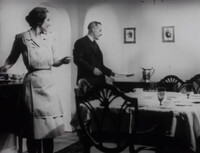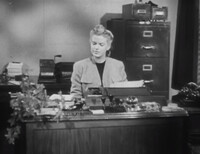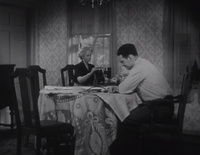Depictions of Women
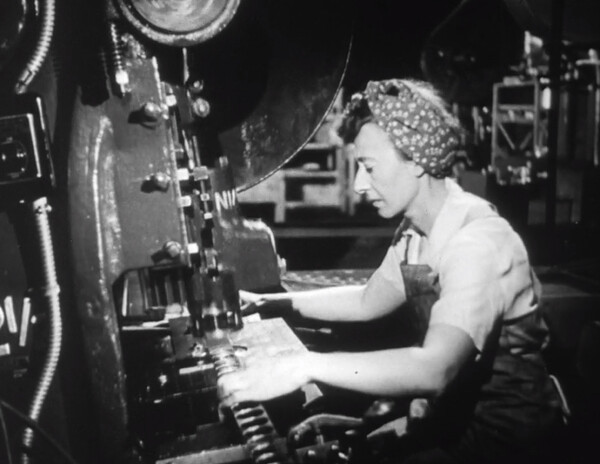
Scenes like this of a woman working an industrial press machine would become common in factories throughout the war.
Desperate for wartime workers, American industry historically turned to a pool of potential labor: women. During the early 1900s, while some women, particularly young women and women of color, did pursue work outside the home, married women from white, middle-class backgrounds largely centered their lives on homemaker responsibilities.46 This would temporarily change with the hostilities of World War I. Millions of men suddenly left the workforce to fight, leaving behind a huge hole in the labor force just as demand for wartime manufactured goods and food spiked. Women were called upon to fill this gap. Some answered for patriotic reasons and some joined the workforce in hopes that demonstrating women’s abilities in the workforce would lead to the granting of women’s suffrage. In the United Kingdom wartime female farm workers would be nicknamed “land girls” while in America they were called “farmerettes,” which carried an underlying negative connotation.47 Suffragists were successful in America, as the right to vote was extended to women in 1920 under the Nineteenth Amendment. After WWI, these women largely left the workforce until U.S. entrance into WWII, where labor shortages were once again prominent.
War declarations by the U.S. at the end of 1941, led to the need for high rates of female employment by the spring of 1942. As millions of men once again volunteered or were drafted into service to fight, the demand for war items caused a massive surge in hiring. Throughout the war, the U.S. would come to create 17 million new jobs, and perhaps the greatest source of untapped labor to fill these new positions came from women.48 Women were not without responsibilities, and had to juggle the new, patriotic call into employment while still maintaining household responsibilities.49 Making sacrifices, women left the home to pursue work in a variety of critical industries, ranging from helping plant and harvest crops to donning the jumpsuits akin to Rosie the Riveter to aid in industrial manufacturing roles. Throughout the entirety of the war, more than 7 million women joined the labor force who had not previously been working or searching for work.50 More than just finding time for paid employment, women were told through advertisements and propaganda by the federal government and private industry to limit unnecessary purchases, conserve food, and to buy war bonds for victory.51 At work women entered traditionally male-dominated spheres, and often faced resistance, stereotypes, or outright discrimination while while on the job. The Office of Education’s Problems in Supervision series highlights many of these challenges in the form of public education films geared specifically towards supervisors and management, but also more broadly to workers.
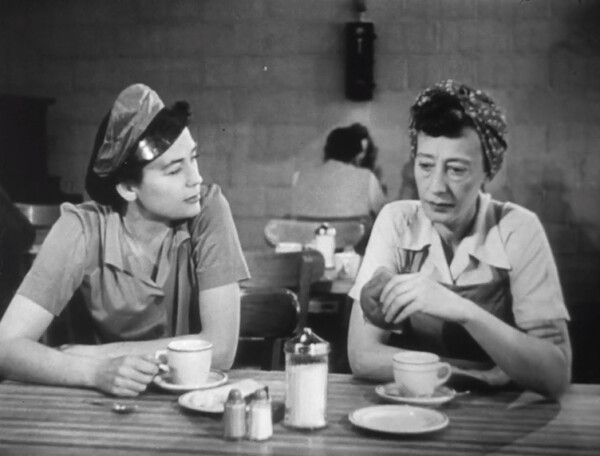
The mass introduction of women to industrial roles necessitated stark changes to daily clothing. Utility overtook fashion for many women.
While at work women faced struggles and stereotypes among male workers. Although 11 million women pursued paid labor before involvement in World War II, the need for wartime manufacturing created new dynamics as women crossed into professions traditionally held by males.52 Worry of male resistance as well as communication and supervision breakdowns from women entering these traditionally male spaces leading to production loss, the Office of Education created the Problems in Supervision series to dispel or work around many of these stereotypes. By modeling the workplace these films also show many commonly held beliefs of male workers at the time, making them a valuable resource for industrial labor historians. One common issue demonstrated in the series was the notion of women being fresh-faced and unfamiliar with basic job functions, like in Supervising Women Workers, when the supervisor Joe mentions his frustration of his new female employees requesting time off to his wife, stating, “You know I had seven requests for time off today. I guess women don’t know what it means to stick on the job.”53 Another stereotype portrayed in the films was women being unfamiliar with machinery, heavy manufacturing, and basic terminology used in these settings, with a major goal of the series to highlight ways of successfully working around such notions. Helpful in dispelling some obvious issues in training and managing women workers, these films also continued to perpetuate stereotypes through supposedly good advice. Going back to the film Supervising Women Workers, the four takeaways the main character Joe (and the perceived audience of managers) is supposed to learn includes: number two, “Women can be offly jealous of each other” and number four, “Women are more sensitive than men.”54 Few women were highlighted in management roles within the series, as these positions were largely reserved for men. The common metaphor of men reserving high level business conversations to male-dominated spaces even played out directly in Working with Other Supervisors, where a group of male supervisors discuss and critique a fellow company leader in the confinement of a men’s locker room.55
Traditional homemaker values were frequently inserted into films, reinforcing the temporary nature of outside labor, like this scene from Improving the Job which the mother and housewife explains workplace efficiency and waste through her roast.
Ideas of women being traditional stay-at-home mothers instead of paid workers reinforced itself throughout the war. Women’s fashion and lifestyle advertisements, while initially altering styles in the name of resource conservation for the war effort, quickly pivoted to a doubling down on femininity as women labored in factory roles. Ads emphasized clean, soft skin and perfect nails in spite of dirty working conditions and the saving of war bonds for future home lifestyle purchases, like dishwashers, to maintain traditional femininity and homemaker ways of living. Encouragements to save money for the future and to maintain feminine beauty standards, especially towards the end of the war, helped to reinforce the notion of paid labor being a temporary hindrance to the ideals of finding a husband and settling down.56 Indeed, marriage statically was central to this generation, which even before the war had high levels of nuptiality.57 Rates of marriage paired with less than effective contraception usage would come to create the Baby Boom in the decades to follow.58 In the Problems in Supervision series, this was highlighted with the lack of women laborers in industrial roles in some films and the prominent inclusion of homemaker wives in others.59 Shots, like at the one minute and 30 second mark of Working with Other Supervisors where a man fiddles with tools on the kitchen table while his wife sews at a machine in the background or the beginning of Improving the Job which depicts a wife cooking and serving a home cooked dinner to her supervisor husband, demonstrate the not-so-implicit domestic and hetersexual values latent within the series.60 The return of war veterans created tension between women who wanted to stay in the workforce and men feeling the societal responsibility to be the breadwinner.61 After securing victory, some women continued professional employment, while others decided to go back to the home.
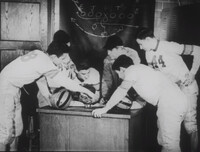
Leadership metaphors in these films were often centered on male pursuits to be relatable to the target audience of male supervisors, as in this shot of a football huddle in Planning and Laying Out Work.

